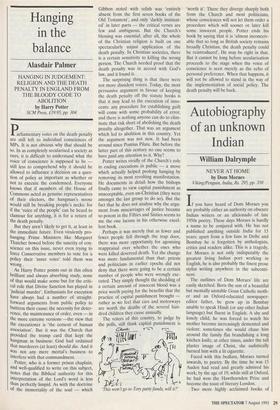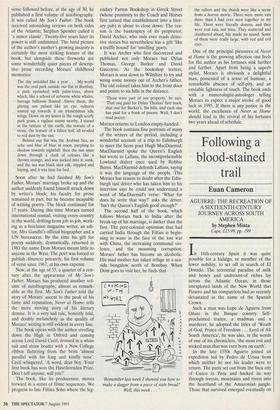Autobiography of an unknown Indian
William Dalrymple
NEVER AT HOME by Dom Moraes Viking/Penguin, India, Rs. 295, pp. 350 If you have heard of Dom Moraes you are probably either an authority on obscure Indian writers or an aficionado of late 1950s poetry. These days Moraes is hardly a name to be conjured with. He has not published anything outside India for 15 years; apart from a few fans in Delhi and Bombay he is forgotten by anthologists, critics and readers alike. This is a tragedy, for Moraes is not only indisputably the greatest living Indian poet working in English, he is also probably the finest prose stylist writing anywhere in the subconti- nent.
The outlines of Dom Moraes' life are easily sketched. Born the son of a beautiful but mentally unstable Goan Catholic moth- er and an Oxford-educated newspaper- editor father, he grew up in Bombay unable to speak Hindi (or any other Indian language) but fluent in English. A shy and lonely child, he was forced to watch his mother become increasingly demented and violent: sometimes she would chase him around the family flat brandishing a long kitchen knife; at other times, under the tall plaster image of Christ, she sadistically burned him with a lit cigarette.
Faced with this bedlam, Moraes turned inwards, to poetry. By the time he was 15 Auden had read and greatly admired his work; by the age of 19, while still at Oxford, he had won the Hawthornden Prize and become the toast of literary London.
Two more highly acclaimed books of verse followed before, at the age of 30, he published a first volume of autobiography. It was called My Son's Father. The book received astonishing reviews on both sides of the Atlantic; Stephen Spender called it `a minor classic'. Twenty-five years later its power is still undimmed. The lurid picture of the author's mother's growing insanity is certainly the most striking feature of the book, but alongside these fireworks are some wonderfully quiet pieces of descrip- tive prose recording Moraes' childhood memories: The day unfolded like a year . . My world was the oval park outside our flat in Bombay, a park eyelashed with palm-trees, above which, like a school of airborne white whales, barrage balloons floated. Above these, the glaring sun pulsed like an eye: vultures soared up towards it on tremendous idle wings. Down on my knees in the rough scurfy park grass, a vigilant nanny nearby, I stared at the texture of the earth, the texture of a stone, the texture of a fallen leaf, all eroded to red dust by the sun.
Behind our flat was the Arabian Sea, an ache and blur of blue at noon, purpling to shadow towards nightfall: then the sun spun down through a clash of colours like a thrown orange, and was sucked into it: sank, and the sea was black shot silk, stippled and lisping, and it was time for bed.
Soon after he had finished My Son's Father, Moraes' marriage broke up and the author suddenly found himself struck down by writer's block; his faculty for prose remained in part, but he became incapable of writing poetry. The block continued for 17 years. During this time Moraes turned international nomad, visiting every country in the world, drifting from job to job, work- ing as a freelance magazine writer, an edi- tor, Mrs Gandhi's official biographer and a UN bureaucrat. By the time his gift for poetry suddenly, dramatically, returned in 1983 the name Dom Moraes meant little to anyone in the West. The poet was forced to publish Absences privately, his first volume of verse since 1967, at his own expense.
Now, at the age of 55, a quarter of a cen- tury after the appearance of My Son's Father, Moraes has produced another vol- ume of autobiography, almost as remark- able as the first. My Son's Father told the story of Moraes' ascent to the peak of his fame and reputation; Never at Home tells the more moving story of his literary demise. It is a very sad tale, honestly told, and doubly melancholy as the quality of Moraes' writing is still evident in every line.
The book opens with the author strolling down the High in Oxford and coming across Lord David Cecil, dressed in a white suit and straw boater with a New College ribbon fluttering from the brim `almost parallel with his long and kindly nose'. Cecil whispered, 'A word, dear boy. Your first book has won the Hawthornden Prize. Don't tell anyone, will you?'
The book, like its predecessor, moves forward in a series of filmic sequences. We progress to late Fifties Soho where the leg- endary Parton Bookshop in Greek Street (whose proximity to the Coach and Horses first turned that establishment into a liter- ary pub) is about to close down. The rea- son is the bankruptcy of its proprietor, David Archer, who only ever reads detec- tive stories but nevertheless has a gift 'like a truffle hound' for 'smelling' poets.
It was Archer who first discovered and published not only Moraes but Dylan Thomas, George Barker and David Gascoyne. As the bookshop teeters, Moraes is sent down to Wiltshire to try and wring some money out of Archer's father. The old colonel takes him to the front door and points to six hills in the distance.
`Those were part of our property,' he says. 'That one paid for Dylan Thomas' first book, that one for Barker's. Six hills, and each one has paid for a book of poems. Well, I don't read poetry.'
Moraes returns to London empty-handed.
The book contains fine portraits of many of the writers of the period, including a wonderful account of a trip to Edinburgh to meet the Scots poet Hugh MacDiarmid. MacDiarmid spoke the Queen's English but wrote in Lallans, the incomprehensible Lowland dialect once used by Robbie Burns. MacDiarmid defends Lallans, saying it was the language of the people. This Moraes has reason to doubt after the Edin- burgh taxi driver who has taken him to his interview says he could not understand a word of MacDiarmid's verse: 'What for does he write that way?' asks the driver. `Isn't the Queen's English good enough?'
The second half of the book, which follows Moraes back to India after the break-up of his marriage, is darker than the first. The post-colonial optimism that had carried India through the Fifties is begin- ning to wane in the face of the lost war with China, the increasing communal vio- lence, and the mounting corruption. Moraes' father has become an alcoholic. His mad mother has taken refuge in a sea- side bungalow north of Bombay. When Dom goes to visit her, he finds that 'Remember last week 1 showed you how to make a dagger from a piece of stale bread? Well, this week . . . '
the rafters and the thatch were like a scene from a horror movie. There were more rats there than I had ever seen together in my life. There were literally dozens; and they were real rats, not mice. They scuttered and clambered about, but made no sound. Some of them were really large, with red and evil eyes ...
One of the principal pleasures of Never at Home is the growing affection one feels for the author as his fortunes sink further and further. Apart from being a superb stylist, Moraes is obviously a delightful man, possessed of a sense of humour, a remarkable absence of self-pity, and an enviable lightness of touch. The book ends with a numerologist-astrologer telling Moraes to expect a major stroke of good luck in 1995. If there is any justice in the world, the excellence of Never at Home should lead to the revival of his fortunes two years ahead of schedule.



















































 Previous page
Previous page